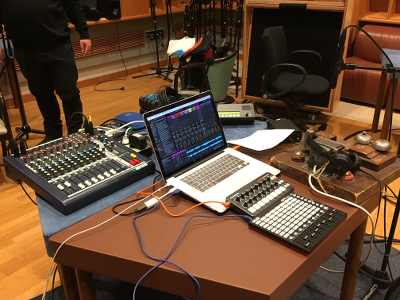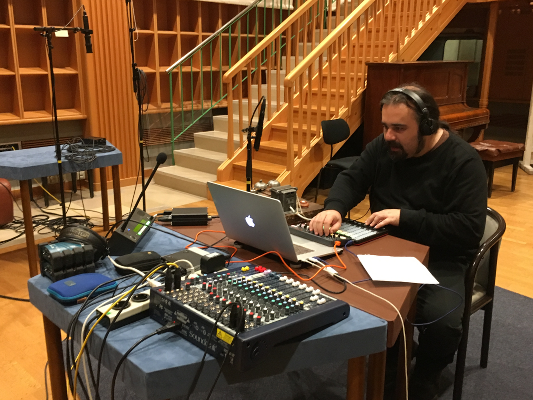According to R. Murray Schafer a soundscape is “[...] any portion of the sonic environment regarded as a field for study.” (SCHAFER 1977).

A soundscape composition consists in both the peculiar characteristics of a given acoustic environment and in the result of a musical composition created through organized sounds, modified or unchanged in their morphology by electroacoustic signal processing. Barry Truax states that each soundscape has its own sound signals, soundmarks and keynote sounds, which configure its identity. He defines the soundscape as "An environment of sound [...] with emphasis on the way it is perceived and understood by the individual, or by a society. [...] The term may refer to actual environments, or to abstract constructions such as musical compositions and tape montages, particularly when considered as an artificial environment." (TRUAX 1999). Thence, according to the author, soundscape compositions have 4 main principles: “a)- listener recognizability of the source material is maintained, even if it subsequently undergoes transformation; b)- the listener’s knowledge of the environmental and psychological context of the soundscape material is invoked and encouraged to complete the network of meanings ascribed to the music; c)- the composer’s knowledge of the environmental and psychological context of the soundscape material is allowed to influence the shape of the composition at every level, and ultimately is inseparable from some or all of those aspects of reality; and ideally, d)- the work enhances our understanding of the world, and its influence carries over into everyday perceptual habits.” (TRUAX 2001)

To consider the soundscape as a compositional artistic activity is to conceptualize it as a sonic praxis that establishes itself in between a continuum of “found sound” and “abstracted sound” approaches, but nevertheless, says Truax, it should imply both a reasonable amount of recognizable sound sources and local (topographic) / psychological contexts related with soundscape events. In this sense, the soundscape composition differentiates itself from other forms of electroacoustic creation as acousmatic music. According to Truax, the context concept is a fundamental principle as it encapsulates the determinations of the identity of the place / land, i.e., its contingent sonic character. Due to the omnipresent nature of sound (physically and perceptually), to study a soundscape necessarily implies to determine epistemological borders and fixate conceptual limits of geographical-topographical, cultural, anthropological, philosophical, aesthetic or social nature. The main problem here is that, as Schafer states, the world is a macrocosmic musical composition and its soundscape corresponds, in fact, to the product of a myriad of endless and ever changing sonic events that interact according to multiple factors. Consequently, to determine a particular soundscape is to segregate, or abstract, from the world’s global soundscape, a sonic point of view that is necessarily a perspective that corresponds to a partial reduction or snapshot of the total soundscape.
The newly founded Soundscape Ecology discipline determines the main interacting factors of the soundscape as: Geophony (the non biological sounds of the earth’s elements and natural events), Biophony (the sounds that animals vocalize and produce) and Antropophony (sounds produced by human technological artifacts); the blending and overlapping of these three factors is entitled Sonotope.
The No Land Soundscape Project is a radio art piece / performance that defies the determinations concerned with the necessity of invocating the knowledge of the context of the place or sonic location, i.e., it reacts against the mimic intent of trying to reproduce an actual sound space as a kind of audio postcard, towards a kind of sonic tourism. For us, soundscape composition is a free mode of electroacoustic creation, based in the artistic recreation of field recordings belonging to whatever aspects of sonotopes / regions of the world. This radio art piece will therefore propose a live composition, at the ORF studios, of an imaginary soundscape about no precise location (hence the no land soundscape project title), a soundscape unrestricted by sound signals, soundmarks and keynote sounds, an attempt to formulate a sonic view upon the world’s cosmic soundscape, an interspersed sound meditation about the notions of space, time, identity and relation. Used sound sources will consist in field recordings captured in several countries / locations by Castro Pinto, from urban and rural / natural environments, excerpts of soundscape / phonography records and audio excerpts of discourses extracted from conferences focused on the topic of soundscape. Sounds of props from the radio art dramas / pieces of the ORF studios will be sampled and manipulated in real time, creating discontinuities between the soundscape of the field recordings and the actual soundscape of the studios of ORF, where the performance will happen. The artist will blend all these elements live during the performance in order to suggest to the audience philosophical and aesthetical questions about what is at stake in the soundscape concept.
The No Land Soundscape Project’s main purpose aims not to depict, as pure phonography does, a mapping of actual spaces / events, but to create new aural narratives that allow distinct perceptions about the used sound source material. The goal is to forge an impromptu sonic space, departing from the actual locations of the sampled sounds to the unknown space of the composition: a field of potentialities and forces, actualized by the composer, that displays imbricate semantic relations which can be questioned, confirmed or contradicted by the listener's aural contingencies.
Listening & Perceiving are subjective forms of creation and the immersion within the world’s sonic events is the essence of being-in-the-world (Heidegger), a mode of being that is full of wonder and aural delights.
____________________________________________________________
SCHAFER, Raymond Murray, Tuning of the World. New York: Knopf. (Republication: The Soundscape – our sonic environment and the tuning of the world. Rochester, VT: Destiny Books. 1994) 1977.
TRUAX, Barry, Handbook for Acoustic ecology, CD-ROM edition. Vancouver: Cambridge Street Publishing, 1999.
TRUAX, Barry, Acoustic Communication. 2nd ed. Westport, CT: Ablex Publishing, 2001.